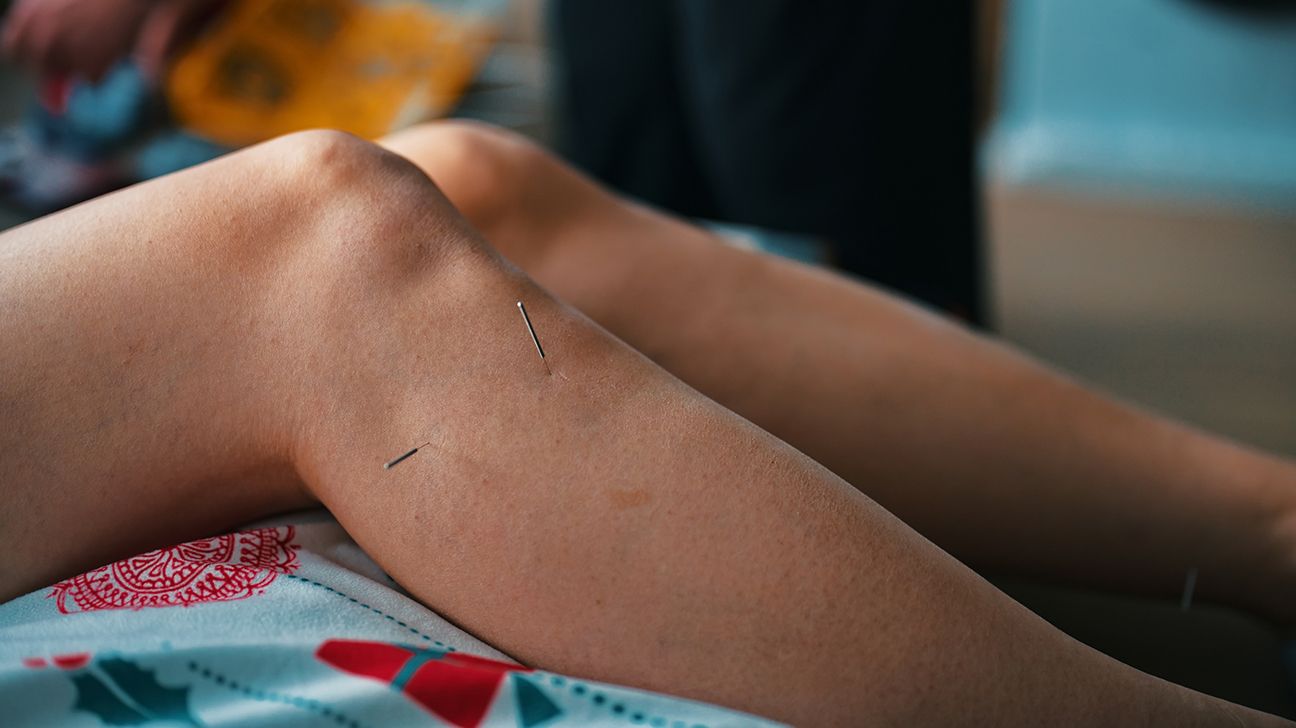How Can Acupuncture Help Restless Leg Syndrome?
While the current research is limited, most available studies show acupuncture to be an effective treatment for those with restless leg syndrome.
 Share on Pinterest Vedrana Sucic/Getty Images
Share on Pinterest Vedrana Sucic/Getty ImagesAcupuncture is a healing practice with thousands of years of history. For centuries, people across Asia have turned to this ancient medicine to relieve various conditions, and this practice continues today.
In modern times, people find acupuncture helpful for chronic pain, hormonal imbalances, headaches, and more. Although acupuncture hasn’t been scientifically proven to relieve the symptoms of restless leg syndrome (RLS), the current research indicates there may be some benefits.
Is acupuncture effective in reducing restless leg syndrome?
Some people with RLS report experiencing benefits from acupuncture treatment. These benefits include relief of RLS pain and discomfort, increased sleep quality, and reduced restless leg sensations.
Acupuncture is considered an alternative or complementary treatment for RLS, and it isn’t fully backed by scientific research. However, some studies suggest that it’s both safe and effective as a possible treatment option for people with RLS.
In a 2023 study analyzing data collected between 2007 and 2022, researchers found that participants with RLS who received acupuncture treatment had significant improvements in factors such as sleep quality.
Additionally, very few side effects were reported in the collected data. The reported side effects were mild and included dizziness, muscle pains, cramps, and joint pain.
A 2021 review found acupuncture to be an effective treatment for those with RLS. It also called for more high quality studies to continue looking into the benefits of acupuncture.
Want to get involved?
If you have RLS and want to help researchers understand how acupuncture or other traditional medicines can help treat your condition, visit ClinicalTrials.gov to look for studies with open admissions.
Before signing up for a clinical trial, be sure to discuss it with your primary healthcare professional first, especially if it involves changes to your current treatment plan.
Drawbacks of acupuncture for restless leg syndrome
Acupuncture isn’t a proven treatment for RLS. Although some data and anecdotal reports suggest that it provides benefits for people with RLS, its use as a treatment for RLS isn’t backed by any major U.S. medical associations.
Since acupuncture isn’t an approved treatment, many insurance providers don’t cover acupuncture, or they may only cover acupuncture for certain conditions. For many people with RLS, that means paying out of pocket for acupuncture treatment. Additionally, a licensed acupuncture practitioner isn’t always easy to find.
While some metropolitan areas have many practicing alternative medicine professionals, others have only a few options. If you live in an area with fewer alternative medicine professionals, it may cost more to see one and you may need to travel a long distance.
Typical side effects of acupuncture can include temporary soreness and a small risk of infection. Seeing a fully accredited acupuncturist can minimize the risk of adverse side effects.
Acupuncture pressure points for restless legs
There are a few acupuncture pressure points that might help soothe restless legs. You can try stimulating these spots on your own with a pressure point massage or gua sha stones. They include:
Other alternative treatments for restless legs
Beyond acupuncture, there are other alternative and lifestyle-related treatments that may help with RLS. These include:
Finding an acupuncturist for restless legs
If you’re interested in trying acupuncture for RLS, it’s important to find a licensed acupuncturist that you can trust. The National Certification Commission for Acupuncture and Oriental Medicine maintains a directory of all the professionals who have achieved their certification.
All the acupuncturists you’ll find listed in this directory have graduated from an accredited educational program and passed a national-level board certification exam.
Takeaway
Acupuncture is an ancient healing practice that many people turn to as an alternative treatment for a variety of health conditions, including RLS. Although acupuncture isn’t currently a recommended treatment for RLS, some research has linked it to benefits such as increased sleep quality and decreased RLS symptoms.
Additionally, there are very few side effects and risks linked to trying acupuncture for RLS. Other alternative treatments for RLS include meditation, stress management, supplements, hot baths, massage therapy, and increased daily exercise.
Posted : 2024-09-30 09:08
Read more

Disclaimer
Every effort has been made to ensure that the information provided by Drugslib.com is accurate, up-to-date, and complete, but no guarantee is made to that effect. Drug information contained herein may be time sensitive. Drugslib.com information has been compiled for use by healthcare practitioners and consumers in the United States and therefore Drugslib.com does not warrant that uses outside of the United States are appropriate, unless specifically indicated otherwise. Drugslib.com's drug information does not endorse drugs, diagnose patients or recommend therapy. Drugslib.com's drug information is an informational resource designed to assist licensed healthcare practitioners in caring for their patients and/or to serve consumers viewing this service as a supplement to, and not a substitute for, the expertise, skill, knowledge and judgment of healthcare practitioners.
The absence of a warning for a given drug or drug combination in no way should be construed to indicate that the drug or drug combination is safe, effective or appropriate for any given patient. Drugslib.com does not assume any responsibility for any aspect of healthcare administered with the aid of information Drugslib.com provides. The information contained herein is not intended to cover all possible uses, directions, precautions, warnings, drug interactions, allergic reactions, or adverse effects. If you have questions about the drugs you are taking, check with your doctor, nurse or pharmacist.
Popular Keywords
- metformin obat apa
- alahan panjang
- glimepiride obat apa
- takikardia adalah
- erau ernie
- pradiabetes
- besar88
- atrofi adalah
- kutu anjing
- trakeostomi
- mayzent pi
- enbrel auto injector not working
- enbrel interactions
- lenvima life expectancy
- leqvio pi
- what is lenvima
- lenvima pi
- empagliflozin-linagliptin
- encourage foundation for enbrel
- qulipta drug interactions
